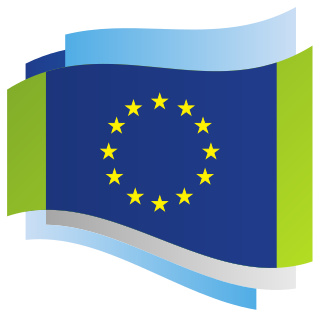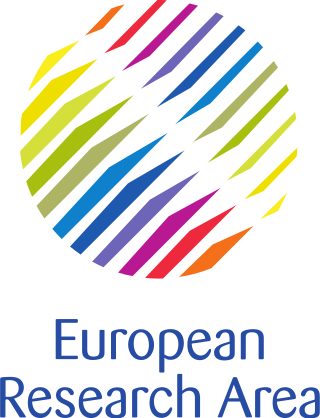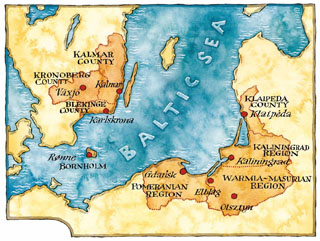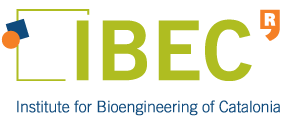Related Research Articles
Nanomedicine is the medical application of nanotechnology. Nanomedicine ranges from the medical applications of nanomaterials and biological devices, to nanoelectronic biosensors, and even possible future applications of molecular nanotechnology such as biological machines. Current problems for nanomedicine involve understanding the issues related to toxicity and environmental impact of nanoscale materials.
Medical physics deals with the application of the concepts and methods of physics to the prevention, diagnosis and treatment of human diseases with a specific goal of improving human health and well-being. Since 2008, medical physics has been included as a health profession according to International Standard Classification of Occupation of the International Labour Organization.

The European Defence Agency (EDA) is an agency of the European Union (EU) that promotes and facilitates integration between member states within the EU's Common Security and Defence Policy (CSDP). The EDA is headed by the EU High Representative for Foreign Affairs and Security Policy, European Commission’s Vice President (HR/VP), and reports to the Council. The EDA was established on 12 July 2004 and is based in Brussels, Belgium, along with a number of other CSDP bodies.
The International Pharmaceutical Federation or Fédération Internationale Pharmaceutique, abbreviated as FIP, is a non-governmental organization (NGO) with official relations with the World Health Organization. It is the global body representing over four million pharmacists, pharmaceutical scientists and pharmaceutical educators through 158 national organisations, academic institutional members and individual members.

The European Research Area (ERA) is a system of scientific research programs integrating the scientific resources of the European Union (EU). Since its inception in 2000, the structure has been concentrated on European cooperation in the fields of medical, environmental, industrial, and socioeconomic research. The ERA can be likened to a research and innovation equivalent of the European "common market" for goods and services. Its purpose is to increase the competitiveness of European research institutions by bringing them together and encouraging a more inclusive way of work, similar to what already exists among institutions in North America and Japan. Increased mobility of knowledge workers and deepened multilateral cooperation among research institutions among the member states of the European Union are central goals of the ERA.
The European Institute of Innovation and Technology (EIT) is an independent body of the European Union with juridical personality, established in 2008 intended to strengthen Europe's ability to innovate. The EIT’s three “core pillars” of activities are: entrepreneurial education programmes and courses across Europe that transform students into entrepreneurs; business creation and acceleration services that scale ideas and budding businesses; and innovation-driven research projects that turn ideas into products by connecting partners, investors, and expertise.
The impact of nanotechnology extends from its medical, ethical, mental, legal and environmental applications, to fields such as engineering, biology, chemistry, computing, materials science, and communications.

The European Institute for Health Records or EuroRec Institute is a non-profit organization founded in 2002 as part of the ProRec initiative. On 13 May 2003, the institute was established as a non-profit organization under French law. Current President of EuroRec is Prof. Dipak Kalra. The institute is involved in the promotion of high quality Electronic Health Record systems in the European Union. One of the main missions of the institute is to support, as the European authorised certification body, EHRs certification development, testing and assessment by defining functional and other criteria.
The Integral SatCom Initiative (ISI) was an Information and Communications Technologies (ICT) European Technology Platform (ETP) led by the European SatCom industry and supported by the European Commission to address Satellite Communications (SatCom) strategic research and innovation challenges. It gathered approximately 200 member organisations representing all the stakeholders of the European SatCom sector from 29 different countries. It included members from manufacturing industry, network operations and service provision, SMEs, research centres and academia, European and National Institutions. Some international research entities do also participate. In 2013, after a public call by the European Commission to re-structure ETPs to better fit Horizon 2020 interests, ISI formally merged with Net!Works ETP to form NetWorld ETP, bringing together almost 1,000 partner organisations. NetWorld would become the partner ETP in the contractual public-private innovation partnership on 5G Infrastructures with the EU in December 2013.
The European Photonics Industry Consortium (EPIC) is a not-for-profit association with headquarters in Paris, France. EPIC serves the photonics community through a regular series of workshops, market studies and partnering. EPIC focuses its actions on LEDs and OLEDs for lighting, optical fiber telecommunications, laser manufacturing, sensors, photovoltaics and photonics for life sciences. EPIC coordinates its activities internationally through its membership in the International Optoelectronics Association.
The Office of the National Coordinator for Health Information Technology (ONC) is a staff division of the Office of the Secretary, within the U.S. Department of Health and Human Services. ONC leads national health IT efforts. It is charged as the principal federal entity to coordinate nationwide efforts to implement the use of advanced health information technology and the electronic exchange of health information.

Nigeria Vision 2020 was a strategic framework for the Federal Republic of Nigeria to develop its economic and political strength to the point by 2020, “Nigeria will be one of the 20 largest economies in the world, able to consolidate its leadership role in Africa and establish itself as a significant player in the global economic and political arena.”

The Euroregion Baltic (ERB) refers to a cross-border Euroregion in the south-east of the Baltic Sea Region, consisting of eight regions of Denmark, Lithuania, Poland, Russia, and Sweden. On 2 March 2022, the ERB's Executive Board suspended Russia's membership, in response to Russia's invasion of Ukraine.

The Medvedev modernisation programme was an initiative launched by President of Russia Dmitry Medvedev in 2009, which aimed at modernising Russia's economy and society, decreasing the country's dependency on oil and gas revenues and creating a diversified economy based on high technology and innovation. The programme was based on the top 5 priorities for the country's technological development: efficient energy use; nuclear technology; information technology; medical technology and pharmaceuticals; and space technology in combination with telecommunications.

One Health is an approach calling for "the collaborative efforts of multiple disciplines working locally, nationally, and globally, to attain optimal health for people, animals and our environment", as defined by the One Health Initiative Task Force (OHITF). It developed in response to evidence of the spreading of zoonotic diseases between species and increasing awareness of "the interdependence of human and animal health and ecological change". In this viewpoint, public health is no longer seen in purely human terms. Due to a shared environment and highly conserved physiology, animals and humans not only suffer from the same zoonotic diseases but can also be treated by either structurally related or identical drugs. For this reason, special care must be taken to avoid unnecessary or over-treatment of zoonotic diseases, particularly in the context of drug resistance in infectious microbes.
Informatics for Consumer Health (ICH) is a government initiative coordinated by the National Cancer Institute (NCI) within the National Institutes of Health (NIH). ICH focuses on a coordination of health information, technology, and health care delivery that empowers providers to manage care and increases the ability of consumers to gain mastery over their own health. The ICH online initiative involved stakeholders from various sectors—commercial IT, government, health care, education, research, and advocacy—exchanging ideas and resources to bridge information technology and health care with the goal of improving behavioral support for all consumers. The Informatics for Consumer Health field is related to health informatics, medical informatics, consumer health informatics, eHealth, and health information technology.
The International Institute for Nanotechnology (IIN) was established by Northwestern University in 2000. It was the first institute of its kind in the United States and is one of the premier nanoscience research centers in the world. Today, the IIN represents and unites more than $1 billion in nanotechnology research, educational programs, and supporting infrastructure.

The Institute for Bioengineering of Catalonia (IBEC) is an institution engaged in basic and applied research in bioengineering and nanomedicine, with experts working on tissue regeneration, biomechanics, molecular dynamics, biomimetics, drug delivery, organs ‘on-a-chip’, cell migration, stem cells, artificial olfaction and microbial biotechnology. The institute was created by the Government of Catalonia, the University of Barcelona and the Polytechnic University of Catalonia in December 2005 and is located at the Barcelona Science Park. The director of the institute is Prof. Josep Samitier, who took over from founding director Josep A. Planell i Estany in 2013. In 2014 IBEC was named a "Severo Ochoa Centre of Excellence" by the Spanish Ministry of Economy and Competitiveness.
The European Federation of Organisations for Medical Physics (EFOMP) was founded in May 1980 in London to serve as an umbrella organisation representing the national Medical Physics societies in Europe. The office moved to Utrecht in January 2021. It is a non-profit organisation and aims to foster and coordinate the activities of its national member organisations, encourage exchange and dissemination of professional and scientific information, develop guidelines for education, training and accreditation programmes and to make recommendations on the responsibilities, organisational relationships and roles of medical physicists.
Horizon scanning (HS) or horizon scan is a method from futures studies, sometimes regarded as a part of foresight. It is the early detection and assessment of emerging technologies or threats for mainly policy makers in a domain of choice. Such domains include agriculture, environmental studies, health care, biosecurity, and food safety.